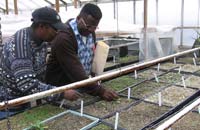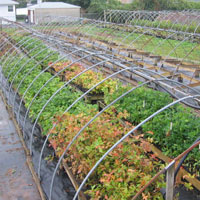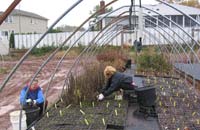The Greenbelt Native Plant Center (GNPC), a facility of the New York City Department of Parks & Recreation, is a 13–acre greenhouse, nursery, and seed bank complex located on Staten Island, NY.
Greenhouse/Nursery Production
The Greenbelt Native Plant Center’s chief mission is to propagate and grow native plants from appropriate local ecotypes for New York City habitat restoration. We collect seed from local plant populations, then germinate and grow plants to the size needed for such restorations.

Greenhouse Program
Plant propagation requires an understanding of how dormant seeds germinate in the soil of their natural environment. Our native seeds have evolved to withstand the harsh winter conditions of the Northeast, so prior to propagation in the artificial conditions of the greenhouse, these and other environmental triggers must first be replicated to break seed dormancy. This involves using physical and biological processes specific to each species. For example, some plants set seed in late summer and eventually make their way into the soil where they are exposed to months of cold, wet conditions before they germinate. Other seeds are eaten by birds and are exposed to stomach acids before they are deposited into the soil.
Many of these pre?conditions have been documented, but many other species are unpredictable, even with the use of published propagation techniques. As we develop our own protocols for the germination of the species native to New York City and the region, we will post our protocols on these pages.
At the GNPC, we:
- Propagate over 336 species of native plants collected from local wild populations.
- Propagate 200,000–400,000 individual plants annually.
- Maintain six greenhouses with 17,000 square feet of bench top production space.
- Maintain a 1,105 square foot propagation range with heated bench top and automated misting system.
- Conduct germination trials to determine best treatment and duration of treatment to achieve maximum germination.
- Record germination and production information in GNPC databases.
Greenhouse Links and Resources
For more information regarding native plant germination and propagation:

Grinnell College–A Guide to Collecting and Germinating Seeds
USDA National Seed Laboratory–Woody Plant Seed Manual
University of New Hampshire Cooperative Extension–Growing Ferns (PDF)
Association of Official Seed Analysts, Inc.
For more information regarding seed dormancy:

Nursery Yard Program
The containerized nursery yard is both a holding facility where mature plants are maintained and irrigated, and a propagation facility in which plants, after germination, are repotted to larger containers to encourage and accommodate root growth. During the winter months of December through May, plants are kept under covered Quonsets to reduce moisture loss, prevent snow damage, and allow an early start to spring growth.
In the growing season, plants are watered when necessary and liquid fertilizer is applied based on leaf color and growth analysis; the current philosophy is to avoid over–fertilizing native plant stock that will eventually be planted in natural areas.
Over the years, our nursery yard manager has gained a great deal of practical knowledge about the cultural requirements to grow and establish our native species. This information is very useful outside of the nursery for those planting and caring for natives. Over time, we will be sharing these recommendations on these pages.
- NPC currently has a total of almost four acres of irrigated nursery yard.
- Pruning of plants in the nursery yard is strictly corrective and sanitary pruning. Our stock reflects the ecotypic variation found in the natural populations they are derived from.
- As with all our plants, stock in the nursery yard is individually accessioned and databased to maintain its provenance back to seed source.
Nursery Links and Resources
For more information regarding forest and container nurseries:

Reforestation, Nurseries, and Genetic Resourses
International Plant Propagators’ Society
For more information regarding invasive plants:
For more information regarding ecological restoration:
Center for Invasive Plant Management
Global Restoration Network (SER)
For more information on regional and general botany:
For more information regarding pest management and control: